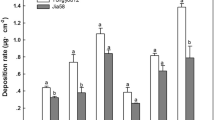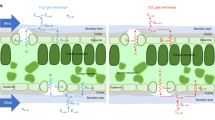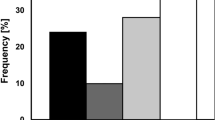Abstract
MANY experiments on foliar absorption have shown that after solutions have been sprayed on the surface of leaves then the upper leaf-blades, which are poor or entirely lacking in guard cells, absorb smaller quantities of solution than the abaxial leaf-blades, which are rich in guard cells1,2. Although foliar absorption cannot occur exclusively through guard cells, since surfaces lacking them also absorb applied substances, it seemed clear that guard cells must play a special part in foliar absorption. Several authors supposed that the stomatal pores were the places for entrance of solutes sprayed on to the cuticle. But the stomatal pores are continuations of the air-filled intercellular system of plant organs and normally function for gas exchange only3. Furthermore, all external and internal surfaces of aerial plant organs which border on air-filled spaces are covered with a layer of lipoidal substances which form a cuticle. These lipoidal substances prevent wetting by hydrophilic solutions. Thus only lipophilic solutes such as oils can penetrate the pores and reach the intercellular spaces4. Under normal conditions, that is, without adding detergents to spray solutions, watery liquids, therefore, cannot be absorbed through the stomatal pores.
This is a preview of subscription content, access via your institution
Access options
Subscribe to this journal
Receive 51 print issues and online access
$199.00 per year
only $3.90 per issue
Buy this article
- Purchase on Springer Link
- Instant access to full article PDF
Prices may be subject to local taxes which are calculated during checkout
Similar content being viewed by others
References
Cook, J. A., and Boynton, D., Proc. Amer. Soc. Hort. Sci., 59, 82 (1952).
Sargent, J. A., and Blackman, G. E., J. Exp. Bot., 13, 348 (1962).
Wetzel, K., Flora (Jena), 117, 221 (1924).
Currier, H. B., and Dybing, C. D., Weeds, 7, 195 (1959).
Franke, W., Amer. J. Bot., 48, 683 (1961).
Franke, W., Planta (Berlin), 57, 266 (1961).
Dybing, D. D., and Currier, H. B., Plant Physiol., 36, 169 (1961).
Author information
Authors and Affiliations
Rights and permissions
About this article
Cite this article
FRANKE, W. Role of Guard Cells in Foliar Absorption. Nature 202, 1236–1237 (1964). https://doi.org/10.1038/2021236a0
Issue Date:
DOI: https://doi.org/10.1038/2021236a0
This article is cited by
-
Size selectivity of aqueous pores in stomatous cuticles of Vicia faba leaves
Planta (2005)
-
Foliar and root absorption of Na+ and Cl? in maize and barley: Implications for salt tolerance screening and the use of saline sprinkler irrigation
Plant and Soil (1996)
-
Cuticular penetration of abscisic acid
Planta (1972)
-
Radialstrukturen in den Stomata vonOuratea spectabilis (Mart.) Engl.
Protoplasma (1968)
-
Foliar absorption — penetration of the cuticular membrane and nutrient uptake by isolated leaf cells
Qualitas Plantarum et Materiae Vegetabiles (1967)
Comments
By submitting a comment you agree to abide by our Terms and Community Guidelines. If you find something abusive or that does not comply with our terms or guidelines please flag it as inappropriate.



